As I mentioned above, I really wish the producers would
tell us the disgorgement date (a month and year or even a quarter and
year would be great). I understand that printing a date on the bottle
may be a pain, but why not have a section on the website where we can
input the Lot code and get information on the bottle? In a perfect
world, I could tell the years & grapes in the blend, vinification,
dosage, disgorgement date, and more just by typing in the lot number (or
some other type of bottle code) into the producer’s website. The
producers already have the information on file and most have websites. I
have to believe this would be a very cost effective way to get
information out to the consumers who care about it. This would also
address the issue of producers who don’t want to “dirty” up their bottle
labels with data that they feel most drinkers don’t care about and could
possibly be scared away by. Come on, who wants to go first?!
Beat up after a game of Sunday night football, the bottle below was
opened following some pizza and Miller Lite. There are a couple
of changes with this vintage of the Grande Année. First off the name has
changed. It is now “La Grande Année" and not just “Grande
Année”. Why the name change, I don’t know, but “The Great Year” does
sound a bit more regal than just plain “Great Year.” I also think “La
Grande Année” looks a little better on the label. However, it is the
second change that I really am excited about. Starting with the 1997
vintage, Bollinger now puts the disgorgement month and year on the La
Grande Année. Since Bollinger disgorges on demand, you can have a
vintage with a 3-4 year swing in disgorgement dates. You couldn’t always
tell what you were drinking before, but now you can. Bravo Bollinger!
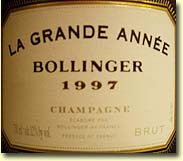 1997
Bollinger La Grande Année
1997
Bollinger La Grande Année
(35%
Chardonnay, 65% Pinot Noir; 75% Grand Crus, 25% Premier Crus; Oak
fermentation; Disgorged September 2004; $75-125 US)
A strong nose dominated by toasted, nutty biscuits mixes with pears and
hints of smoke. It is rather one dimensional in its expression and shows
more maturity than I would expect at this point, but I would rather have
a wine that chooses a side than one that can’t decide what it wants to
be. The palate shows a mix of dry citrus acidity, tart pears, yeast, and
hard biscuits. The finish is rather abrupt as it starts full of citrus
fruit, but then dries up and drops off the face of the earth. It fights
to come back with hints of sweet cream, but it doesn’t quite make it.
The dryness in this wine is a bit worrisome and the abundance of acid to
fruit is as well. I can’t see this aging very well and it most likely
will peak by age 15 and then become dominated by a dried out acidity.
That doesn’t mean it isn’t a very good wine. It is a good example of the
1997 vintage and one to enjoy over the next 5 years.
Grade of Low B+ (86-88 pts). Find this wine
We recently got a Boston Terrier puppy and to celebrate we opened the
bottle below. This bottle is a private label made by the Beaumont des
Crayeres Cooperative and imported into the US by Eagle Eye
Imports. Why someone needs a special bottle just for them, I don’t
know, but someone must think it makes good business sense. The label on
this bottle is unique as Ay artist Jacky Colson paints a scene of
Champagne the wine and Champagne the terroir.
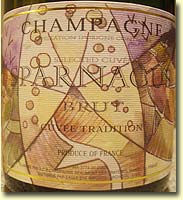 NV
Sparnacus/Domaine de l’Epine produced by Beaumont des Crayeres
NV
Sparnacus/Domaine de l’Epine produced by Beaumont des Crayeres
(40% Chardonnay, 40% Pinot Noir, 20%
Pinot Meunier; Some oak fermentation; Disgorged November 2006; $35-45
US)
Gentle aromas of citrus blossoms, cream, and dough go perfectly with
this wine’s light hay color. It just gives off the impression of a lazy,
late summer dusk. As for the palate, a good dose of orange & mellow pear
mix with some minerals & fresh biscuits to bust this bad boy out of the
gate. However, after that, this wine doesn’t quite live up to its early
billing. Fluffy earth notes add a flabbiness that isn’t very
attractive. A bitter citrus bite that comes out on the harsh and
somewhat thin finish is also quite disappointing. With some time the
bitterness fades a bit and a sweet creamy citrus note replaces it, but
the finish always comes off a bit harsh.
While I was not thrilled with the bottle, I did find a good use for it.
It can be used in replacement of Bitter Lime to keep your pets from
chewing on the furniture. To me, this wine looks and tastes like a
rebadged Beaument des Crayerers Grand Prestige Brut… so again,
why is this bottle out there as a special cuvee? I don’t like it when
car companies rebadge the same car under different divisions and I don’t
like it when wine companies do it either. This isn’t a bad Champagne,
but there is better out there for the price.
Grade of low B- (79-81 pts). Find this wine
The Lamiable family are growers in the Grand Cru Pinot Noir village of
Tours-sur-Marne (Chardonnay is only Premier Cru in this village).
Jean-Pierre Lamiable, a sports medicine physician and his daughter
Orianne Crepeaux-Lamiable are the winemakers at this estate which
dates back to 1600. However, the family has only been in Champagne since
1929.
They own six hectares (approximately 15 acres) of which 4.5 are devoted
to Pinot Noir and 1.5 to Chardonnay. The soil is made up of limestone
and chalk. Their principal vineyard sites include Les Meslaines
(50-60 year old vines) and Clos de Goesse (35-40 year old vines).
The top cuvee is the Cuvee Les Meslaines, which is of course 100%
Pinot Noir from the Les Meslaines vineyard.
I remember running into a bottle of this sometime in 2004 and thinking,
“Wow, a 1999 already on the streets of Michigan.” Since Michigan
seems to get Champagne about a year after the rest of the US, I wonder
if other folks were running into this wine in 2003? I purchased and
popped a bottle a few years back and found it rather bland and
disjointed. It wasn’t memorable. I wondered if time had helped it so I
decided to try it again.
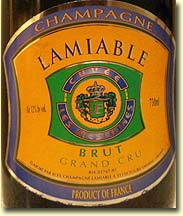 1999
Lamiable Cuvee Les Meslaines Grand Cru
1999
Lamiable Cuvee Les Meslaines Grand Cru
(100% Pinot Noir; Tours-sur-Marne; Single
Vineyard- Le Meslaine; Dosage 8 g/L; Disgorged 2003?; $60-75 US)
A single vineyard, old vine Pinot Noir? Now that gets me excited!
Unfortunately thinking about opening the bottle was the peak of the
experience. Once the cork was popped, I found that this wine really
needs some time to breathe as it gave nothing for the first hour or so.
Eventually, it started to give off some very light aromas of pear and
citrus, but it was on day two that this showed best on the nose, when creamy, juicy pears and citrus spiked minerals found their way in.
They never shouted or spoke loudly, but at least they were more than a
whisper.
The palate was consistent with the nose in that it was most expressive
on the second day. A couple of hours after opening, this showed pears, a
bit of yeast, and some light citrus. However on day two, it became much
more expressive. Flavors of bitter citrus, spiced minerals, thorn laced
biscuit dough, and watery pears lead the way into a gooey, creamy,
drying finish that just seems wrong.
I don’t like the wine. It is expressive and it gets credit for
that, but I don’t like what it is saying. I’m not sure what went wrong
here, but I think some extra time on the lees could have helped. As it
is, it isn’t worth $25 let alone $60. Remember that a single vineyard,
old vines, or grower label do not guarantee quality any more than a
fancy shield on a bottle or cellophane wrapper does.
Grade of C (73-76 pts).
Find this wine
I have had the Domaine Ste. Michelle tete de cuvee (using that term
loosely here) sparkler Luxe quite a few times going back to late 2004.
The first time I tried it, I found it to be a decent wine for the price
(B-, 80-82 pts) and thought it had the potential to turn into a pretty
good value. Further tastings in 2005 (C+, 77-79 pts) and 2006 (High C
75-77 pts) showed this to not be true as the wine appeared to be getting
worse. I figured it was time for another update so I cracked another
bottle.
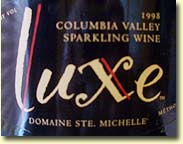 1998
Domaine Ste. Michelle Luxe
1998
Domaine Ste. Michelle Luxe
(100% Chardonnay; Columbia Valley,
Washington, USA; First fermentation in Frecnh oak and then aged for 11
months; Dosage 9.5 g/L; 12.8% alc; Disgorged late 2004; $12-20 US)
If they say first impressions are worth millions, this bottle is worth
about a dollar. A rather amylic nose greets me with scents of fluffy,
bitter fake pear & peach, and stale 25-year-old Topps baseball card
bubble gum. The flavors aren’t much better as bitter, thin, dried out
citrus mixes with some bland dough and a bit of canned fruit cocktail
pear and peach. The finish is horrible as it is like I am
licking the old wedding envelopes that killed George’s fiancé on
Seinfeld. As with previous tastings, there is a strange, yet
attractive, chocolate flavor that plays hide and seek on the palate and
finish. That is about the only positive I can find in this wine on day
1.
On day 2, I found this to be a little more appealing (relatively
speaking). It isn’t anything more than a slightly below average wine,
but at least some juicy pear joins in the bland and dry flavor parade.
But, on a whim, I tried something different. I poured the bubbly into a
Riedel Vinum Riesling/Chianti glass (I normally use the Riedel
Restaurant Champagne glass for tasting) and it became somewhat
drinkable. Some sweet peach and pear meshed with fluffy citrus and
bourbon-like oak notes. In a way it reminded me of a poor imitation of a
young Newton unfiltered Chardonnay toned down and bubbled up. It
still wasn’t a great wine, but it was clearly better. In fact, I found
more of a difference with this in the different glasses then I have
ever seen with a sparkling wine before.
This could have been something, but I don’t feel it was handled
right. The oak and aging regime doesn’t seem to fit the wine. This would
seem to me to be one to ferment/age in steel or minimal oak and then
disgorge and drink when still younger and fresh to accentuate the fruit.
If you are not Champagne, pay homage, but don’t try to be Champagne. You
will come off as a poser like this wine does. But, I’m not a winemaker
so what do I know except that this wine keeps getting worse as time goes
on? For half the price, give me one of Chateau Ste. Michelle’s NV
bubblies over this… and that is saying something as I don’t like
many of those either. I’m also beginning to wonder what to do when
bubbly improves a day after being open, but still doesn’t show much
potential to improve in the bottle. Add to this the fact that varying
the glass it is served in can also alter the experience. Who the heck
opens a bottle of bubbly, doesn’t drink it for a day, and experiments
with different glasses (besides me)? When it comes to recommending
wines, I need to figure out the best way to handle situations like this.
Grade of D+ (67-69 pts). However, if you desire
to achieve my level of bubble-dorkhood wait a day and serve this in a
white wine glass, I think you will get a C/C+ experience (74-77 pts). Find this wine
I’ve been waiting to try the 1998 E. Barnaut Champagne since
placing an order for it sometime in the fall of 2006. It finally arrived
in my neck of the woods and I gladly took my delivery home the same day
it arrived. I fell in love with the 1996 on release only to see it turn
into a strange yucky animal over the last 1.5 years. I hope the 1996 is
only in a strange state, but my gut tells me that the truth lies
elsewhere. Outside of the Cuvee Edmond, other E. Barnaut
bottlings have been very inconsistent lately. Inconsistent enough to
make me wonder if hygiene is a problem at the winery or there are major
problems with transport or local storage. Despite this, only the juice
can do the talking so a bottle of the 1998 was popped.
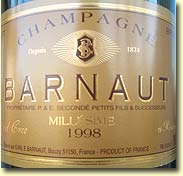 1998
E. Barnaut Millesime Brut
1998
E. Barnaut Millesime Brut
(50% Chardonnay, 50% Pinot Noir; Bouzy
Grand Cru; Fermented in steel; Malolactic Fermentation; Disgorged 2006;
$40-55 US)
A big mousse gives way to a very open and fragrant nose that kicks up
aromas of spicy peaches, pears, biscuits, and a healthy dose of chalk.
Normally I’m not a big fan of upfront chalk, but this wine balances it
out well with the other aromas and in the end the chalk adds to the
wine. The flavors in this wine are just as big as the nose as yeasty,
slightly spicy biscuits and racy citrus lead a band made up of apples,
pears, and sherry flavored chalk. This is one heck of a flavorful wine
and has many similarities to a young Bollinger Grande Année, only it is a
couple of Jackson’s less expensive.
This is a tremendous wine and really busts out of the box when you give
it an hour or two to breathe and warm up. While it is a completely
different flavor expression than the 1996, it is just as good when
young. I hope the bottle variation, quality, or “whatever the heck it
is” problems at E. Barnaut have been solved because I am once again
going out on a limb and scoring this wine high with excellent potential.
Just be wary that past cuvees have also been this good with this much
promise on release and then laid a big smelly goose egg over time.
Grade of Low A- (89-91 pts) with A- potential
(90-92 pts). Find this wine
Sometimes a night just calls for slummin’ (or my wife yells at me that I
am dead if I open anything more than $10), but when it comes to slummin’,
Cristalino is tops in my book. For $5, all three of their cuvees
are great buys. I will admit to being a Cristalino drinker and a proud
one at that. Yes, there is plenty of bubbly that is better out there,
but at $5? I don’t think so. Even at $10-$12, this puts up a good fight.
My favorite has normally been the Cristalino Rosé with the Cristalino
Brut and Extra Dry a small notch behind, but not on this night.
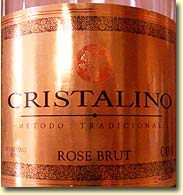 NV
Jaume Serra Cristalino Rosé
NV
Jaume Serra Cristalino Rosé
(60% Pinot Nior, 40% Trepat; Penedes,
Spain; Methode Tradicional; 18-24 months aging on the lees; Dosage 15
g/L; Disgorged January 2007 $5-8 US)
Soft cherry red/pink in the glass and I cannot deny that this is rather
appealing to look at. Normally, I find Cristalino Rosé to be a good
value, but nothing more than that. However, this time this smells rather
good too. A hefty nose of soft cherries, red grapefruit, and a few horse
aromas engulf me. I didn’t think the horsiness was that bad, but my wife
thought the dog had gone to the bathroom in the house so I’m not sure
you brett haters would have liked this particular bottle. I’ve never
noticed this level of brett in Cristalino Rosé before so I was
interested in how this would respond with some time to breathe.
Unfortunately, time was not its friend. Within an hour the nose had
developed a rather appealing cherry citrus character, but it was
completely hidden by a now even greater amount of horse droppings.
Warmth, however, did seem to change the wine as it got rid of the horse
and replaced it with plastic.
After a nose like that, I didn’t know what to expect. What I ended up
finding was a bland acidity with some cherry and Catholic communion
wafer flavors. The finish is rather short, but it is clean with a creamy
mineral and paper citrus note. Strange as it sounds, the finish wasn’t
that bad (especially compared to the rest of the wine). I have had
enjoyable bottles of Cristalino Rosé, but this wasn’t one of them. Then
again I have spent 10-15 times as much on bottles that were just as bad
or worse. I know bottle variation is high on these high volume, low
price sparklers, but based on my experience the Rosé seems to be
especially susceptible to wide swings in quality.
Grade of C- (70-72 pts) for this bottle, but I
think it was slightly flawed. I have had bottles of this that have been
as high as a low B- (79-81 pts) in the past. Find this wine
Completely out of the blue, but does anyone else know of a Cava that
uses as much Trepat in the blend (or even any Trepat in the blend) as
the Cristalino Rosé?
NV Jaume Serra Cristalino Brut
(Macabeo 50%, Xarel-lo 15%, Parellada
35%; Penedes, Spain; Methode Tradicional; 18-24 months aging on the
lees; Dosage 9 g/L; Disgorged January 2007; $5-8 US)
A bright golden yellow color leads into a heavy and somewhat earthy,
amylic fluffy gumdrop or Carefree bubblegum nose that is a trademark
of Cava. Notes of peach, fresh linen, light citrus, and cinnamon also
enter into the equation. That palate is simple, but it does its job. It
is light and fresh and leaves your mouth tingling as it gives you a
dollop of cream, linens laundered in citrus detergent, and a bitter
mineral note. The finish is short and shows some quickly dried up cream
notes. Nothing offensive and nothing to write home about, but at $5, it
is a buy in my book. Good bubbly for the price.
Grade of C+ (77-79 pts). Find this wine
NV Jaume Serra Cristalino Extra Dry
(Macabeo 50%, Xarel-lo 15%, Parellada
35%; Penedes, Spain; Methode Tradicional; 18-24 months aging on the
lees; Disgorged January 2007; $5-8 US)
The nose is not as sweet as my last bottle with only touches of powder
sugar. What I really like is the clean citrus and pear character that is
clearly defined underneath the sweetness. Flavors of slightly bitter
citrus, fluffy cotton candy, yellow apples, and yellow pears lead into a
short and clean finish kissed by candied orange notes. As with the Brut
above, this is nothing to write home about, but quite enjoyable while
being light on the pocket book. Grade of C+
(77-79 pts). Find this wine
Overall, as I mentioned above, these bottles are a high volume product
and do see a good deal of bottle variation. I gave specific bottle
ratings above, but in general I would give these wines a greater range.
For the Brut and Extra Dry, I think you can expect a C/C+ (75-80 pts)
wine. For the Rosé, the range is a bit wider and you can expect a C to
B- (73-81 pts) experience. Regardless of the score, these are excellent
values and Jaume Serra should be commended for putting out such
good quality sparkling wines at such a low price. It is a true sign of a
nice wine when I can drink a bottle over and over again and not get sick
of it. I’ve been drinking Cristalino for years and I’m still not sick of
it.
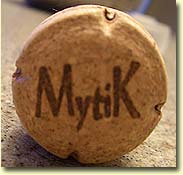 I
must also commend Cristalino for using the Mytik Diamant Cork. I
don’t have any studies at hand that show that this cork is better than a
traditional cork, but I believe that it shows great promise in
eliminating TCA and many general sparkling wine cork failures. You can
learn more about the Mytik Diamant
here.
Now, if Cristalino can put this type of closure on a $5 wine, no one can
give me an excuse for why they aren’t trying to improve their closure
quality. But, then again, there is always the duo of wines below…
I
must also commend Cristalino for using the Mytik Diamant Cork. I
don’t have any studies at hand that show that this cork is better than a
traditional cork, but I believe that it shows great promise in
eliminating TCA and many general sparkling wine cork failures. You can
learn more about the Mytik Diamant
here.
Now, if Cristalino can put this type of closure on a $5 wine, no one can
give me an excuse for why they aren’t trying to improve their closure
quality. But, then again, there is always the duo of wines below…
 Since
I am always a sucker for a cheap bottle of bubbly that I have never
tried before, I decided to pick up the Henri Maire Finette Blanc de
Blancs Brut (100% chardonnay; Jura, France) and Henri Maire
Finette Demi-Sec Rosé (no clue on the grapes; Jura, France). They
were $5 each and showed just how great a deal Cristalino is. I bought
two of each cuvee (each bottle from a different case) and all four of
them suffered from cork problems. They wines weren’t corked, but the
corks did not perform their job. Two of the bottles had no sparkle and
contained grossly deformed corks that were soaked all the way up the
cork neck. The other two bottles had a tiny bit of sparkle to them and
more disfigured corks.
Since
I am always a sucker for a cheap bottle of bubbly that I have never
tried before, I decided to pick up the Henri Maire Finette Blanc de
Blancs Brut (100% chardonnay; Jura, France) and Henri Maire
Finette Demi-Sec Rosé (no clue on the grapes; Jura, France). They
were $5 each and showed just how great a deal Cristalino is. I bought
two of each cuvee (each bottle from a different case) and all four of
them suffered from cork problems. They wines weren’t corked, but the
corks did not perform their job. Two of the bottles had no sparkle and
contained grossly deformed corks that were soaked all the way up the
cork neck. The other two bottles had a tiny bit of sparkle to them and
more disfigured corks.
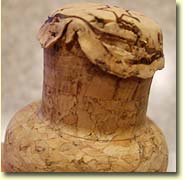 Now,
when I say deformed/disfigured, I want you to picture a preschooler
given the task of creating a Champagne cork by gluing various pieces of
cork together. Now look at their creation as perfection because the
corks in the Finette bottles were so horrible that they would make the
preschooler’s cork look like perfection. I have never seen such abysmal
quality control. I wish I could blame the importer/distributor/store,
but the disfigured corks show that blame should rest with the winery.
Now,
when I say deformed/disfigured, I want you to picture a preschooler
given the task of creating a Champagne cork by gluing various pieces of
cork together. Now look at their creation as perfection because the
corks in the Finette bottles were so horrible that they would make the
preschooler’s cork look like perfection. I have never seen such abysmal
quality control. I wish I could blame the importer/distributor/store,
but the disfigured corks show that blame should rest with the winery.
Now I can already hear the yells of, “But it was only $5.” So
what, I say. After all, Cristalino is only $5 and is continuing to make
investments into high quality as shown by their Mytik Diamant
cork usage. Price cannot be used as an excuse here.
I didn’t get a chance to taste the wines as they were meant to be so I
can’t rate them. What I will say is that the quality control showed by
Henri Maire doesn’t leave me thrilled (I have had cork and wine
quality problems with bottles of Henri Maire’s Vin Fou as well) and
would prevent me from recommending the wines even if they were good. For
now, these get a no-score with an asterisk that reads that they are a
failure due to poor quality control. Shape up your wines Henri Maire or
ship out!
How I long for the good ol’ days when no one cared about
Philipponnat’s Clos des Goisses. It has always been a first growth
of Champagne, but it was unheralded for so long that I always took
access to older vintages of it for granted. Well, the last 3-5 years
have seen all of that change and now one of my favorites has hit the big
time with platinum records and groupies to show. Lucky for me, I was
able to dive into a couple oldies, but oh so goodies.
For those of you not familiar with Clos des Goisses, it is the
tete de cuvee (top wine) of Philipponnat. It is a also a rare single
vineyard Champagne. The Clos des Goisses vineyard is located in the
Premier Cru of Mareuil-sur-Ay (shows why you can’t always pay
attention to Cru status). If you look at the terroir of this wine, it is
quite unique as the 5 ½ hectacres planted to both Pinot Noir (70%) and
Chardonnay (30%) experience a climate that is unlike not only the rest
of Mareuil-sur-Ay, but the rest of Champagne as well. There is a very
steep south slope that fully ripens even in the worst of years (and can
fry in the hot ones) and a more gentle eastern slope that provide grapes
that ripen more consistently with the rest of Champagne. This allows
Philipponnat to make good wines in both good and bad vintages. It also
shows off the winemaking skills of the team as each vintage requires a
different mix of the super-ripe southern and more gentle eastern fruit.
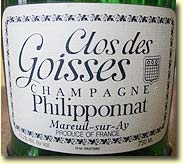 1975
Philipponnat Clos des Goisses
1975
Philipponnat Clos des Goisses
(30% Chardonnay, 70% Pinot Noir; Single
vineyard in Mareuil-sur-Ay; $225-325 US)
A soft and gentle mousse rolls up in the glass and matches the golden
and slightly orange color perfectly. It is showing its age, but also
still saying that it has some fight left in it. As for the nose, oh man,
it is gorgeous. Aromas of candied orange, toasted butterscotch crumpets,
tangerine, and sherried pears fill the air. The palate isn’t a let down
either as I would swear that I was eating a baked hard biscuit topped
with melting sweet cream and laced with tropical fruit and caramel
coated nuts.
This wine is just plain gorgeous. I have had a few tired bottles (from
poor storage) over the last few years, but this bad boy was kicking it
up. Just go buy Clos des Goisses from any vintage while it is still
reasonably priced. It is truly a gem and not so easy to find as
production varies between only 3500 and 30,000 bottles each vintage.
Grade of Solid A (94-95 pts). Find this wine
1980 Philipponnat Clos des Goisses
(30% Chardonnay, 70% Pinot Noir; Single
vineyard in Mareuil-sur-Ay; $175-250 US)
After tasting the 1975, the 1980 was a step down. That said, I would
take this “step down” any day, any time. Oddly, this showed both more
mature and more youthful notes than the 1975. It was livelier in the
glass and the nose had wonderful hints of dried apricots and
concentrated orange mixed with dark mocha. The palate followed this same
trend as orange, tangerine, dried peach, mocha hard biscuits, and coffee
made for a spunky mature profile that seemed at or near its peak. The
finish was the only bump in the road as thin and slightly bitter orange,
chocolate, and peach biscuit notes seemed to be trying, but not quite
doing.
1980 was not the greatest vintage, but this is a great bottle and along
with the 1980 Dom Perignon out of Magnum (the 1980 Dom Magnums
are much better than the 750 mL original and late disgorged bottles) is
my pick for top wine of the vintage. Overall, this showed a bit more
fruit than the Dom while the Dom has more dark coffee and chocolate
notes.
After writing the above, I looked up what Richard Juhlin thought
of this wine and he too compared it to the 1980 Dom Perignon. Always
makes me chuckle when things like this happen.
Grade of High A- (91-93 pts). Find this wine
I’ll close out by mentioning that I had another bottle of NV Veuve
Clicquot Yellow Label last week. This one was disgorged in
July-August of 2006 and was not only younger, but also better than any
of the regular 750 mL bottles that I tasted
in my Yellow Label review. Right
from the cork pop, the bottle showed a nice creamy biscuit and pear
aspect that was fruit forward and appealing. Still a tad dirty, but not
green at all. Overall, a pleasant surprise and enough to scrape in with
a Low B- (80-81 pts). Find this wine
Cheers!
Brad Baker
BACK TO THE TOP
BACK TO BRAD BAKER'S
INDEX PAGE
May 2007 © Brad Baker


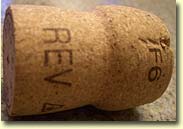 4.
Very similar to the Lot code above, the cork will sometimes have a code
written on it. Just like the Lot code above, you can often learn to
decipher the disgorgement date from the cork code. When you can’t, you
can always contact the producer and ask for help. The only negative to
cork codes is that you have to open the bottle before you can determine
when the bottle was disgorged.
4.
Very similar to the Lot code above, the cork will sometimes have a code
written on it. Just like the Lot code above, you can often learn to
decipher the disgorgement date from the cork code. When you can’t, you
can always contact the producer and ask for help. The only negative to
cork codes is that you have to open the bottle before you can determine
when the bottle was disgorged. 1997
Bollinger La Grande Année
1997
Bollinger La Grande Année NV
Sparnacus/Domaine de l’Epine produced by Beaumont des Crayeres
NV
Sparnacus/Domaine de l’Epine produced by Beaumont des Crayeres 1999
Lamiable Cuvee Les Meslaines Grand Cru
1999
Lamiable Cuvee Les Meslaines Grand Cru 1998
Domaine Ste. Michelle Luxe
1998
Domaine Ste. Michelle Luxe 1998
E. Barnaut Millesime Brut
1998
E. Barnaut Millesime Brut NV
Jaume Serra Cristalino Rosé
NV
Jaume Serra Cristalino Rosé I
must also commend Cristalino for using the Mytik Diamant Cork. I
don’t have any studies at hand that show that this cork is better than a
traditional cork, but I believe that it shows great promise in
eliminating TCA and many general sparkling wine cork failures. You can
learn more about the Mytik Diamant
I
must also commend Cristalino for using the Mytik Diamant Cork. I
don’t have any studies at hand that show that this cork is better than a
traditional cork, but I believe that it shows great promise in
eliminating TCA and many general sparkling wine cork failures. You can
learn more about the Mytik Diamant
 Since
I am always a sucker for a cheap bottle of bubbly that I have never
tried before, I decided to pick up the Henri Maire Finette Blanc de
Blancs Brut (100% chardonnay; Jura, France) and Henri Maire
Finette Demi-Sec Rosé (no clue on the grapes; Jura, France). They
were $5 each and showed just how great a deal Cristalino is. I bought
two of each cuvee (each bottle from a different case) and all four of
them suffered from cork problems. They wines weren’t corked, but the
corks did not perform their job. Two of the bottles had no sparkle and
contained grossly deformed corks that were soaked all the way up the
cork neck. The other two bottles had a tiny bit of sparkle to them and
more disfigured corks.
Since
I am always a sucker for a cheap bottle of bubbly that I have never
tried before, I decided to pick up the Henri Maire Finette Blanc de
Blancs Brut (100% chardonnay; Jura, France) and Henri Maire
Finette Demi-Sec Rosé (no clue on the grapes; Jura, France). They
were $5 each and showed just how great a deal Cristalino is. I bought
two of each cuvee (each bottle from a different case) and all four of
them suffered from cork problems. They wines weren’t corked, but the
corks did not perform their job. Two of the bottles had no sparkle and
contained grossly deformed corks that were soaked all the way up the
cork neck. The other two bottles had a tiny bit of sparkle to them and
more disfigured corks.  Now,
when I say deformed/disfigured, I want you to picture a preschooler
given the task of creating a Champagne cork by gluing various pieces of
cork together. Now look at their creation as perfection because the
corks in the Finette bottles were so horrible that they would make the
preschooler’s cork look like perfection. I have never seen such abysmal
quality control. I wish I could blame the importer/distributor/store,
but the disfigured corks show that blame should rest with the winery.
Now,
when I say deformed/disfigured, I want you to picture a preschooler
given the task of creating a Champagne cork by gluing various pieces of
cork together. Now look at their creation as perfection because the
corks in the Finette bottles were so horrible that they would make the
preschooler’s cork look like perfection. I have never seen such abysmal
quality control. I wish I could blame the importer/distributor/store,
but the disfigured corks show that blame should rest with the winery.
 1975
Philipponnat Clos des Goisses
1975
Philipponnat Clos des Goisses